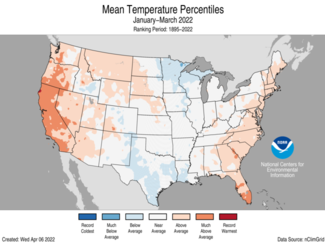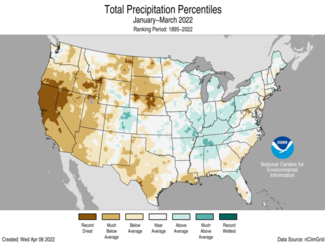Record drought conditions across West raise concerns for summer dry season

The current multi-year drought across the West is the most extensive and intense drought in the 22-year history of the U.S. Drought Monitor. Precipitation deficits during the first three months of 2022, across parts of the western U.S., are at or near record levels. As the climatological wet season ends across portions of the West, with below average snow cover and reservoirs at or near record-low levels, concerns for expanding and intensifying drought and water resource deficits are mounting.
During March, the average contiguous U.S. temperature was 44.1°F, 2.6°F above the 20th-century average. This ranked in the warmest third of the 128-year period of record. The year-to-date (January-March) average contiguous U.S. temperature was 36.3°F, 1.2°F above average, ranking in the middle third of the record. The March precipitation total for the contiguous U.S. was 2.26 inches, 0.25 inch below average, and ranked in the driest third of the 128-year period of record. The year-to-date precipitation total was 5.66 inches, 1.30 inches below average, ranking seventh driest in the January-March record.
This monthly summary from NOAA National Centers for Environmental Information is part of the suite of climate services NOAA provides to government, business, academia and the public to support informed decision-making.
March
Temperature
- A large cold-air outbreak across the central U.S. occurred during the second week of March. Despite this cold spell, temperatures for the month as a whole were above average across much of the West and from the Midwest to the East Coast. Temperatures were below average in pockets along the western Gulf Coast during March.
- The Alaska March temperature was 16.6°F, 5.8°F above the long-term average. This ranked in the warmest third of the 98-year period of record for the state. Temperatures were above average across most of the state with Anchorage and Talkeetna reporting a top-10 warm March.
Precipitation
- Precipitation was above average from the central Plains to the Great Lakes, as well as across parts of the Deep South and Southeast. Precipitation was below average across much of the West, northern and southern Plains and from the Tennessee Valley to the Mid-Atlantic and parts of the Northeast. North Dakota ranked seventh driest on record, while Michigan ranked eighth wettest for the month.
- Several severe weather outbreaks produced strong and damaging tornadoes during March.
- On March 5, supercell thunderstorms produced at least 13 confirmed tornadoes across Iowa including a confirmed EF4 tornado in Winterset.
- On March 21-22, severe weather and tornadoes were reported from Texas to Alabama including an EF3 tornado that substantially damaged two Jacksboro, Texas, schools and an EF3 tornado that ripped through the New Orleans metro area.
- Another severe weather outbreak impacted the Gulf Coast states on March 30-31 from Louisiana to Florida with at least 14 tornadoes and 2 fatalities confirmed.
- Precipitation across southeastern Alaska during March was above average. Following the wettest January and February on record, Juneau remained wet in March, ranking 10th wettest. As a result, the first three months of the year were the wettest on record and also the wettest January-April on record with the entire month of April still in play. End-of-March snowpack was above average across much of mainland Alaska with some locations near record high levels.
- According to the March 29 U.S. Drought Monitor report, nearly 58 percent of the contiguous U.S. was in drought, down from 59 percent at the beginning of March. Drought conditions intensified and/or expanded across portions of the Southeast, Plains, southern Rockies, parts of the West Coast and Hawaii. Drought intensity and/or coverage lessened across parts of the northern Great Lakes. During March, the contiguous U.S. drought footprint reached 61 percent — the largest observed extent of drought since the fall of 2012.
Year-to-date (January-March)
Temperature
- Temperatures were above average across much of the West and along the East Coast. California ranked sixth warmest for the January-March period. Temperatures were below average across portions of the Upper Mississippi Valley and the Deep South.
- The Alaska January-March temperature was 9.6°F, 3.7°F above the long-term average, ranking in the warmest third of the record for the state. Above-average temperatures were observed across much of the southern half of the state with the warmest departures from average occurring in portions of south-central Alaska.
Precipitation
- Precipitation was above average across eastern Colorado and from the Mid-Mississippi Valley to the Great Lakes and into the Northeast. Precipitation was below average across much of the West, northern Plains, Deep South and parts of the Southeast and Mid-Atlantic states during the January-March period. California and Nevada ranked driest on record while South Dakota ranked second driest for this three-month period.
- Precipitation averaged across Alaska for the January-March period was generally above average with the Southeast Interior and portions of the Panhandle regions ranking wettest on record.
Billion-Dollar Weather and Climate Disasters
- During the first quarter of 2022, no new billion-dollar weather and climate disasters have been identified, although several events are currently being evaluated.
- In early April 2022, NCEI added an additional 13 historical weather and climate events which, through inflation and review, surpassed the billion-dollar threshold. The U.S. has now sustained 323 weather and climate disasters since 1980 where overall damages/costs reached or exceeded $1 billion (based on Consumer Price Index adjustment to 2022). The total cost of these 323 events exceeds $2.195 trillion.
For more detailed climate information, check out our comprehensive March 2022 U.S. Climate report scheduled for release on April 13, 2022.








